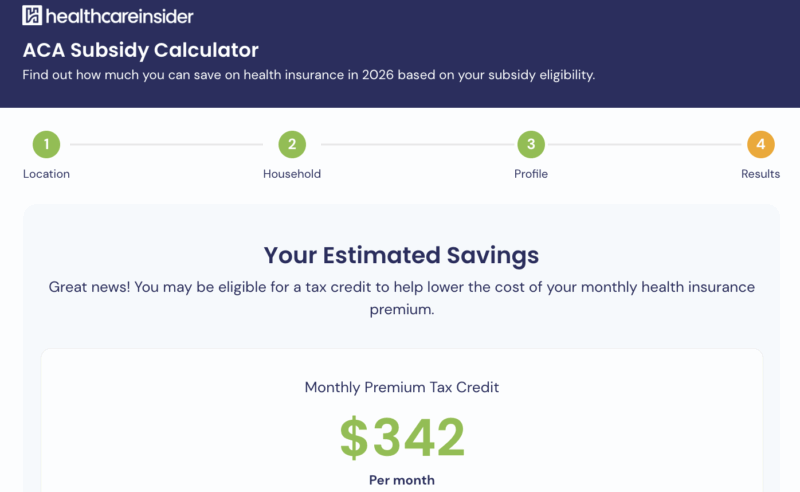
Written by Adrienne Lin
We want to help you make educated healthcare decisions. While this post may have links to lead generation forms, this won’t influence our writing. We adhere to strict editorial standards to provide the most accurate and unbiased information.
Key Takeaways
- Enhanced ACA subsidies from the American Rescue Plan—extended through 2025—are set to expire unless renewed, meaning that in 2026, Premium Tax Credits will likely apply only to individuals and families earning between 100% and 400% of the Federal Poverty Level (FPL).
- ACA premiums for 2026 are increasing, with approved state increases ranging from 6.7% to 53% across the U.S.
- Without renewal, monthly premiums could rise sharply for middle-income enrollees.
- Open Enrollment for 2026 begins November 1, 2025, giving consumers time to compare options and adjust coverage.
- Some states may mitigate price hikes with reinsurance programs or state-funded subsidies.
As enhanced Affordable Care Act (ACA) subsidies are set to expire, millions of Americans are wondering if they’ll still qualify for financial help — and how much they might pay for health coverage next year.
For 2026, finalized rate filings show premium increases across most states, raising urgent questions about affordability and access for those who depend on marketplace plans.
Why ACA Premiums Are Rising in 2026
Health insurance premiums fluctuate annually, but 2026 marks a sharper shift. Several factors are converging.
1. The Projected End of Enhanced ACA Subsidies
The American Rescue Plan Act (ARPA) and Inflation Reduction Act (IRA) temporarily expanded ACA subsidies, also known as premium tax credits, through 2025, making ACA plans more affordable for millions.
Unless Congress renews the policy, these enhanced subsidies will end after the 2025 plan year, returning eligibility to pre-ARPA levels.
To qualify for ACA subsidies in 2026, it’s projected that your income must be high enough that you don’t qualify for Medicaid but low enough to remain eligible for financial assistance. Individuals and families earning between 100% and 400% of the Federal Poverty Level (FPL) generally qualify for Premium Tax Credits that reduce monthly premiums.
For 2026 coverage (based on 2025 FPL guidelines):
-
Single person: about $15,650–$62,600 per year ($1,304–$5,217 per month)
-
Family of four: about $32,150–$128,600 per year ($2,679–$10,717 per month)
If your household income falls within these ranges, you’ll likely qualify for ACA subsidies. The exact amount depends on your income, family size, and location.
2. Sharp State-Level Rate Increases & Medical Cost Pressures
Most states are reporting double-digit premium hikes before subsidies are applied. Here’s a snapshot of some approved 2026 average rate changes across the ACA individual market:
2026 ACA Premium Rate Changes by State (Highest → Lowest)
| State (or DC) | Marketplace Type | Approved 2026 Average Change |
|---|---|---|
| New Mexico | State-based | +52% |
| New Hampshire | Federally-facilitated | +51% |
| Arizona | Federally-facilitated | +46.3% |
| Mississippi | Federally-facilitated | +36.8% |
| Arkansas | Federally-facilitated | +35.8% |
| Wyoming | Federally-facilitated | +35% |
| Florida | Federally-facilitated | +34% |
| Texas | Federally-facilitated | +32% |
| West Virginia | Federally-facilitated | +30% |
| Tennessee | Federally-facilitated | +30% |
| Illinois | State-based | +28.8% |
| Indiana | Federally-facilitated | +26.3% |
| Maine | State-based | +23–24% |
| Pennsylvania | State-based | +21.5% |
| Washington | State-based | +21% |
| Rhode Island | State-based | +21% |
| Maryland | State-based | +13.4% |
| Massachusetts | State-based | +11.7% |
| California | State-based | +10% |
| Idaho | State-based | +10% |
| Oregon | State-based | +9.7% |
| South Dakota | Federally-facilitated | +8.9% |
| North Dakota | Federally-facilitated | +8.9% |
| District of Columbia | State-based | +8.7% |
| New York | State-based | +8% |
| Vermont | State-based | +6.7% |
(Data from state insurance departments, CMS filings, and ACA Signups tracker, 2025)
A friendly team of licensed insurance agents is here to guide you.
3. Medical Inflation and Utilization Trends
Health care costs themselves are climbing faster than general inflation. Drivers include:
- Higher hospital and prescription costs post-pandemic
- Increased utilization as preventive and elective care rebounds
- Expanding provider networks and administrative expenses
Insurers are pricing in these pressures for 2026, anticipating both greater claims and continued uncertainty in policy renewals.
4. Reduced Federal Cost-Sharing Support
Some carriers anticipate fewer federal cost-sharing reduction (CSR) payments due to shifting enrollment patterns. This often leads to Silver-tier “load pricing” — where premiums rise disproportionately on Silver plans to offset expected losses.
Consumers who shop around can sometimes find Gold or Bronze plans with comparable premiums.
What Happens If Congress Doesn’t Extend Subsidies?
If the enhanced subsidies lapse:
- Roughly 13 million Americans could see premium increases overnight, according to KFF.
- Middle-income households may face the biggest jumps — up to $200–$400 per month, depending on location and plan.
- Enrollment could decline as healthy individuals drop their coverage, further raising costs for those who remain.
However, a few states (e.g., California, New Mexico, Washington) are exploring state-funded subsidy extensions to buffer the impact.
When Is Open Enrollment for Health Insurance 2026?
When are the Open Enrollment Dates?
- November 1 – January 15 (in most states)
- Enroll by December 15 for coverage starting January 1, 2026
- Enroll by January 15 for coverage starting February 1, 2026
Some states have different deadlines:
- Idaho – enrollment ends December 16, 2025
- Massachusetts – open through January 23, 2026
- Virginia – open through January 22, 2026
- California, New Jersey, New York, Rhode Island, and DC – extended through January 31, 2026
Looking ahead: Starting with the 2027 plan year, all states will move to a December 31 enrollment cutoff for consistency across marketplaces, according to the Centers for Medicare & Medicaid Services (CMS).
Tip: Don’t wait until the final week — system traffic surges near the deadline can delay application processing. If you want coverage to start January 1, apply by mid-December.
How to Prepare for Higher ACA Premiums
Here’s what you can do to stay covered — and save where possible:
- Update your income and household info during open enrollment to ensure accurate subsidy calculations.
- Use our ACA subsidy calculator (Health Insurance Marketplace calculator) to estimate your eligibility.
- Compare across metal tiers. Gold or Bronze plans may offer better value if Silver prices spike due to CSR loading.
- Explore state-specific aid. Some marketplaces may continue extra subsidies for low-income residents.
Alternatives If You Don’t Qualify for a 2026 Subsidy
If your income or eligibility excludes you from subsidies, consider these alternative ACA Plan Options if you and your family are not eligible.
Flexible options, such as short-term medical insurance, fixed-benefit plans, supplemental coverage, faith-based programs, and bundled dental or vision plans, may offer flexible and affordable protection tailored to your specific needs.
-
- Short-Term Medical Plans: Great for people between jobs, recent grads, or gig workers. Offer fast enrollment (sometimes next day), preventive care, copays, and telemedicine — typically at a lower cost with national networks.
- Supplemental Insurance: Ideal for those with high deductibles or minimal coverage. Includes accident, critical illness, hospital, and cancer policies available year-round for added protection against medical bills.
- Dental & Vision Insurance: Perfect for families, students, or budget-conscious individuals. Covers exams, cleanings, glasses, and LASIK with bundled savings and early detection benefits.
- Health Care Sharing Ministries: Faith-based communities where members share medical costs through monthly “shares” instead of premiums — budget-friendly and values-driven.
- Fixed Benefit Medical Insurance: Designed for low-income, student, or self-employed individuals. Pays fixed amounts per service with no deductibles, works with other plans, and offers direct payments without network restrictions.
Work with a licensed insurance agent — they can help find plans with lower net costs or better value for your health needs.
Quick FAQ
When do enhanced ACA subsidies expire?
At the end of the 2025 plan year, unless Congress renews them.
Will health insurance premiums increase in 2026?
Yes, approved filings show widespread premium hikes, even before subsidies end.
Why are health insurance premiums going up?
Rising medical costs, utilization, and reduced federal support are primary drivers.
What can I do if I can’t afford coverage?
Check for Medicaid eligibility, catastrophic plans (if under 30 or hardship-qualified), alternative ACA plans, or local aid programs.
Bottom line
The coming year could reshape how budget-friendly ACA coverage remains. With many states already approving 2026 premium increases, the expiration of enhanced subsidies could mean a sharp rise in out-of-pocket costs for millions.
Your best move? Act early during open enrollment, compare all options, and verify subsidies before they change. Even small steps — like updating your marketplace profile — can protect you from unexpected cost spikes.
Thank you for your feedback!







